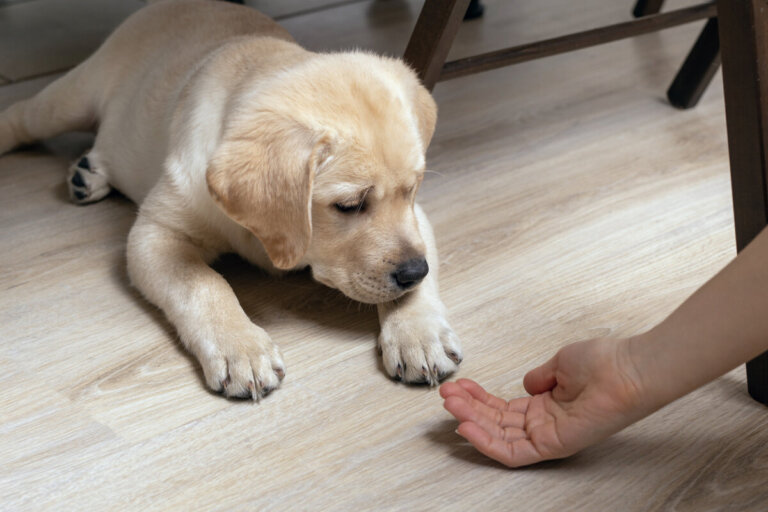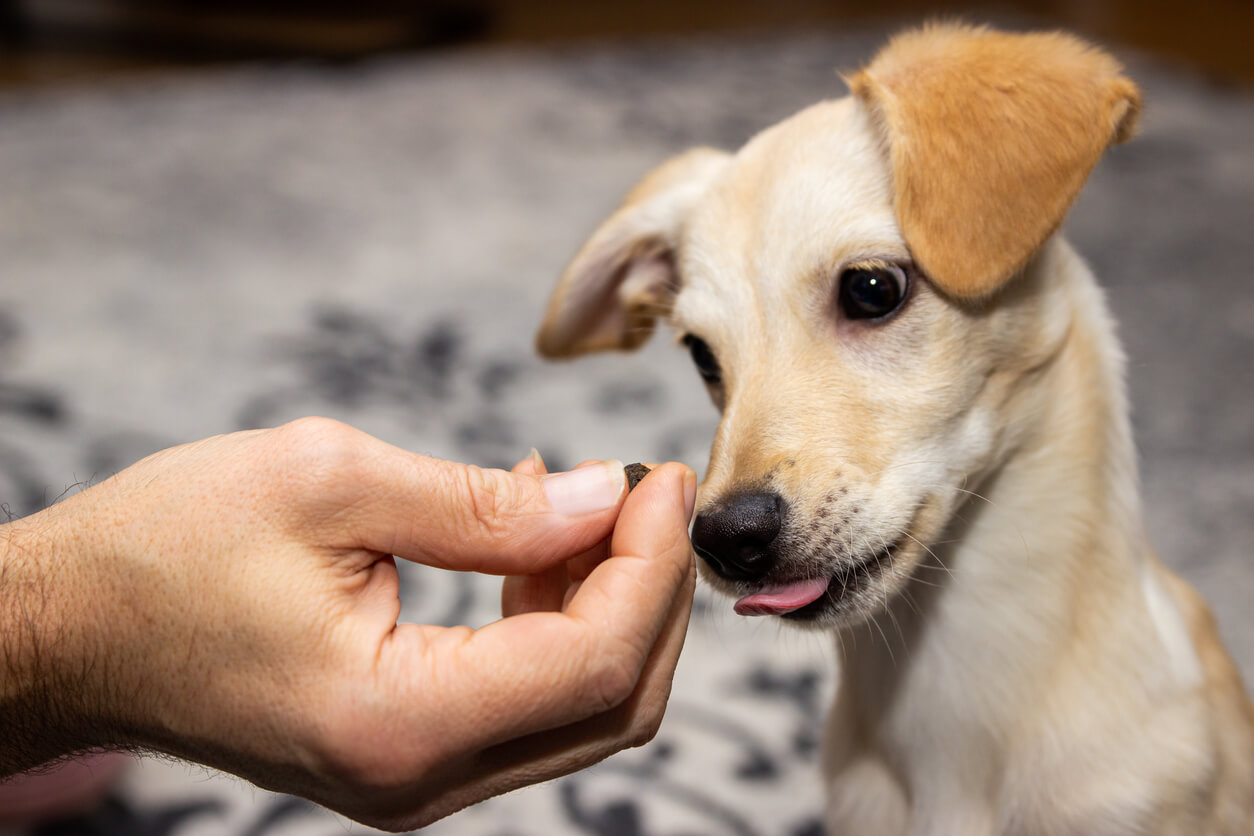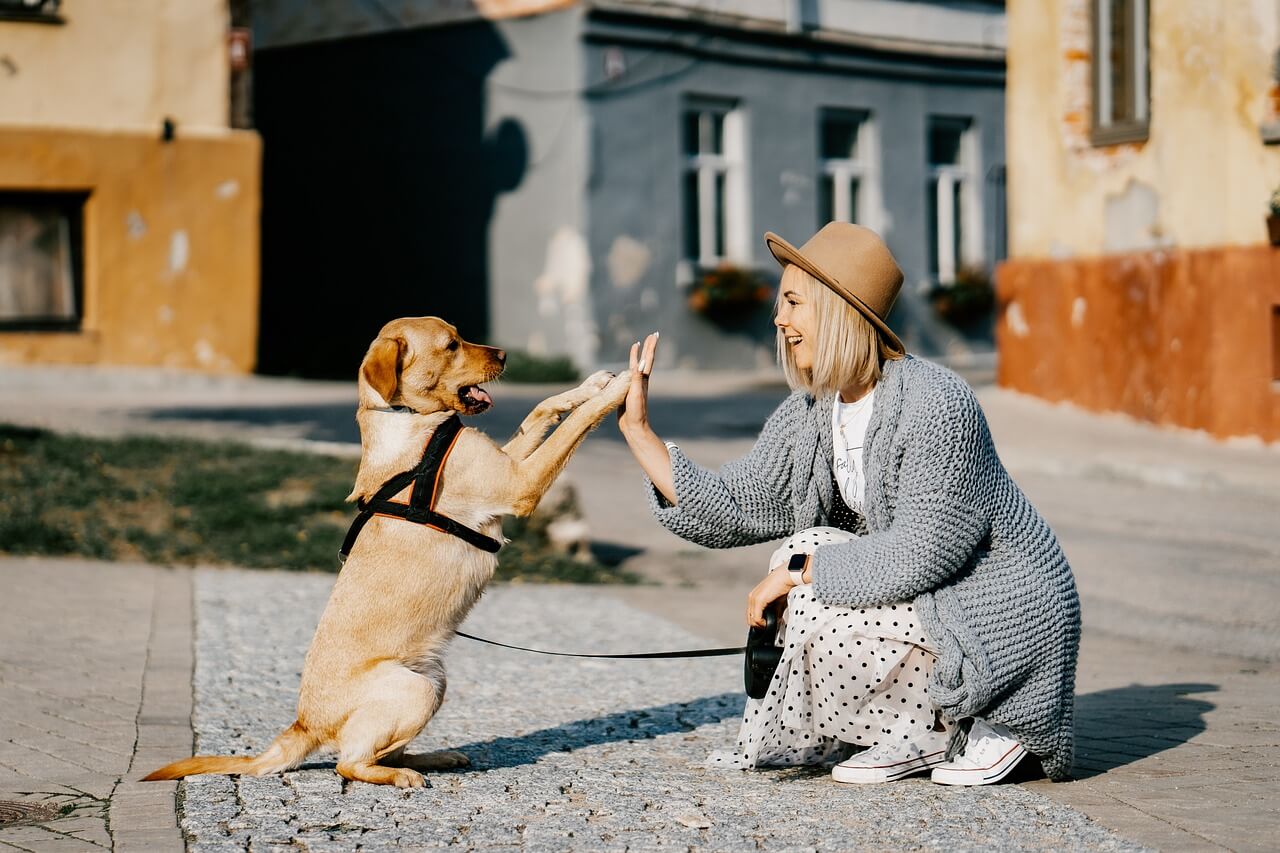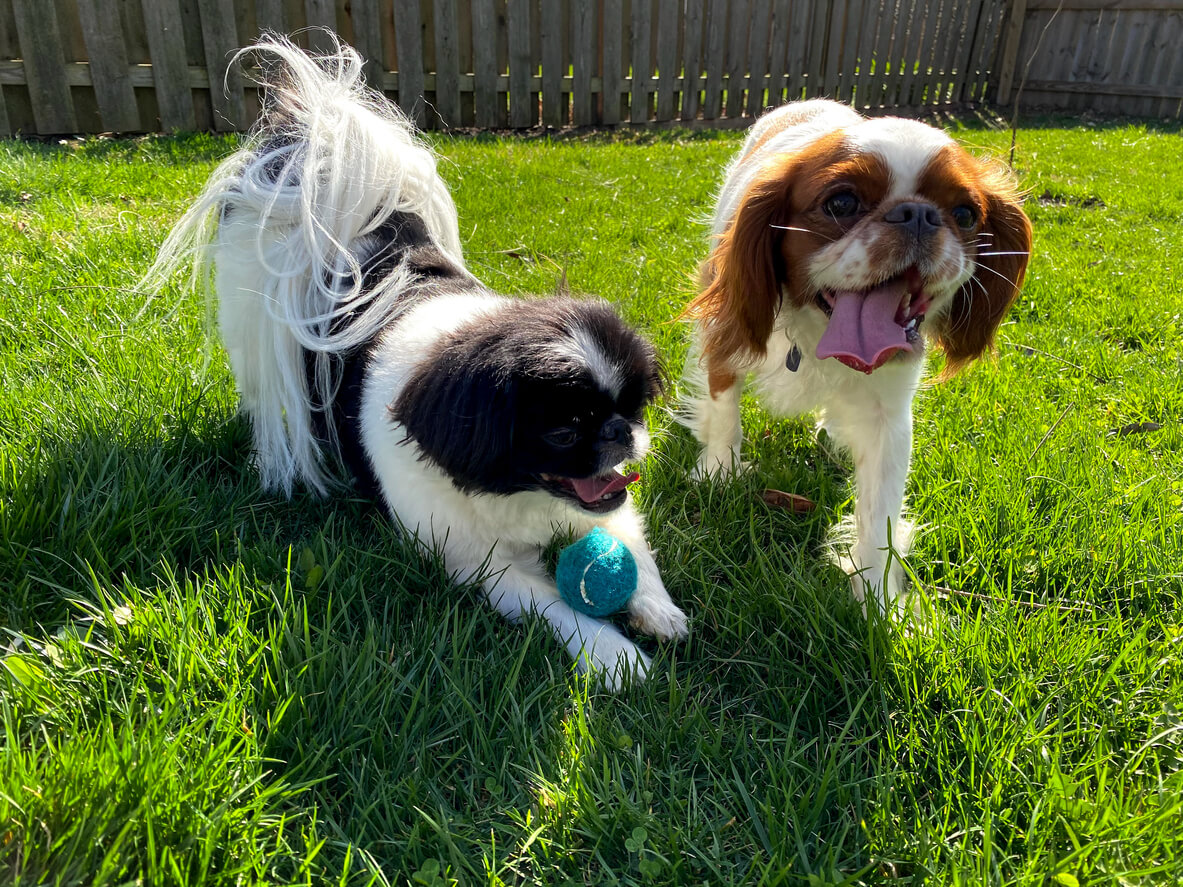Training a Puppy: 10 Easy Tricks that Work


Written and verified by the psychologist Sara González Juárez
Training a puppy isn’t only about teaching it funny tricks, as that adorable little fur ball also needs an education that will turn him into an independent and functional adult. Otherwise, unwanted and dangerous behaviors could appear, such as destroying things or hurting other dogs.
If a puppy has just arrived in your life and you’re going to start training it for adulthood, we advise you to practice positive reinforcement, encourage its independence, and establish a routine. If you want to learn more about these and other simple techniques, we invite you to read the following article. Don’t miss anything, as these tips will make the process much easier for you.
When is a dog considered a puppy?
Permeability to learning and energy levels change throughout a dog’s life. A puppy goes through a period of socialization in which it learns everything it needs to survive from its family. This stage begins around four weeks of age.
Small-sized dogs reach adulthood at 9-12 months. In the case of large breeds, childhood and adolescence are extended until almost two years of age. As you can see, in both cases, you have plenty of time to train your puppy.
This doesn’t mean that adult dogs don’t have the ability to learn, but that at young ages, training is much faster.
Ten tricks to training a puppy
Dogs learn everything from their mother and develop the ability to relate to their siblings. When they’re taken from their original family and given to a human, that human needs to make up for that learning so that the dog’s able to live a full and happy life. Therefore, take advantage of these tips to make your puppy’s education as effective as possible.
1. Always use positive training

Punishing a puppy only instills fear. The learning they’ll extract from it is that they shouldn’t engage in certain behavior in front of you so that nothing bad happens to them, but they won’t learn the usefulness of the behavior you want to see. Therefore, it’s always better to reward what you want to encourage, rather than punish what you want to eliminate.
For example, it’s better to reward your dog when it gets off the sofa when you give it the command than to punish it when it gets on it.
2. Teaching your puppy to sit
Successfully training your puppy to sit when you ask it to is very helpful in setting the pace for many moments of daily life. From going to greet a friend calmly to waiting before eating from the dish, that pause will help regulate your little one’s level of nervous activation.
3. Use short commands

“Sit” is better than “sit down.” Dogs have a great facility for recognizing words in human speech and even differentiate languages, but it’s best to make it easy for them to accelerate learning in their puppy stage.
4. Use counter-conditioning
When your puppy does something undesirable, ask it for a response that’s incompatible with whatever it is they’re doing. For example, when it lunges to greet another dog while barking, tell your pup to sit and wait. With repetition, you’ll get its first impulse before starting an interaction to be to sit and relax.
5. Don’t start specific training until your puppy has mastered the previous one
Although the rules of coexistence at home are practiced daily, teaching your dog specific commands must be done in an orderly manner. In addition, many commands give way to others, so it’s a good idea to have the basics well learned. In this regard, from “sit” you can go to “down,” or from “drop” you can go to “fetch” (to play ball, for example).
This makes things easier for your puppy, as it helps it to distinguish your commands and reinforces its learning. It also avoids confusion.
6. Training a puppy is also involves letting it socialize

A dog needs to socialize with others of its own kind to ensure optimal psychological development, as well as to maintain its emotional well-being. That’s why it’s important to limit your interventions when your pup is interacting with other canines.
Pay attention to signs that indicate that the interaction isn’t going well, such as the following:
- Fighting
- Biting
- Growling that’s not playful
Also, correct your puppy when it insists on approaching a dog that has rejected it several times. It’s not a bad thing if it gets a growl from a fellow dog, but don’t let the situation escalate.
7. Also reward your puppy with cuddles and toys
One of the best ways to get a dog to let go of something in its mouth is to exchange it for something. Since you can’t always offer food, rewarding it with cuddles is another very good option to reinforce desirable behavior. Likewise, you can offer a toy that it really likes so that it’ll let go of whatever it’s chewing. In time, your dog will learn to read your request and make the exchange.
8. Agree with your family on how to train your puppy
Consistency is essential when training a puppy. If your family uses different verbal commands or rewards inconsistently, the dog will feel nothing but confusion. For this reason, it’s ideal to train together and agree on certain limits.
9. Establish a routine
Dogs enjoy their daily routine. It gives them security because they know when they’ll receive food or when they’ll be able to relieve their needs. If this is already valuable for adults, it’s a crucial basis for a puppy’s character development. So, don’t hesitate to go out, feed, and play with your dog at similar times. Your puppy will appreciate it.
10. Encourage your puppy’s independence
Some very essential learning -such as walking on a leash, peeing outside, or playing without biting- requires somewhat lengthy processes. In addition, many of them involve several steps.
Along the way, treats and cuddles multiply, but they should only be used to help your dog develop these basic skills. It’s fine to keep rewarding it for respecting the limits set for it or while performing tricks, but ideally, your dog should be able to manage in its adult life without the need for reinforcement at every step.
And, above all, patience
Training a puppy requires a deep breath on many occasions. Sometimes, you’ll need to replace objects or furniture, mom up pee, pick up poop, receive bites, or experience embarrassing moments in the park.
For this reason, and despite the great capacity for learning that dogs have in their developmental stage, never lose your temper. Remember that, apart from teaching it to be a well-behaved dog, you’re also creating a bond of love with your puppy.
Training a puppy isn’t only about teaching it funny tricks, as that adorable little fur ball also needs an education that will turn him into an independent and functional adult. Otherwise, unwanted and dangerous behaviors could appear, such as destroying things or hurting other dogs.
If a puppy has just arrived in your life and you’re going to start training it for adulthood, we advise you to practice positive reinforcement, encourage its independence, and establish a routine. If you want to learn more about these and other simple techniques, we invite you to read the following article. Don’t miss anything, as these tips will make the process much easier for you.
When is a dog considered a puppy?
Permeability to learning and energy levels change throughout a dog’s life. A puppy goes through a period of socialization in which it learns everything it needs to survive from its family. This stage begins around four weeks of age.
Small-sized dogs reach adulthood at 9-12 months. In the case of large breeds, childhood and adolescence are extended until almost two years of age. As you can see, in both cases, you have plenty of time to train your puppy.
This doesn’t mean that adult dogs don’t have the ability to learn, but that at young ages, training is much faster.
Ten tricks to training a puppy
Dogs learn everything from their mother and develop the ability to relate to their siblings. When they’re taken from their original family and given to a human, that human needs to make up for that learning so that the dog’s able to live a full and happy life. Therefore, take advantage of these tips to make your puppy’s education as effective as possible.
1. Always use positive training

Punishing a puppy only instills fear. The learning they’ll extract from it is that they shouldn’t engage in certain behavior in front of you so that nothing bad happens to them, but they won’t learn the usefulness of the behavior you want to see. Therefore, it’s always better to reward what you want to encourage, rather than punish what you want to eliminate.
For example, it’s better to reward your dog when it gets off the sofa when you give it the command than to punish it when it gets on it.
2. Teaching your puppy to sit
Successfully training your puppy to sit when you ask it to is very helpful in setting the pace for many moments of daily life. From going to greet a friend calmly to waiting before eating from the dish, that pause will help regulate your little one’s level of nervous activation.
3. Use short commands

“Sit” is better than “sit down.” Dogs have a great facility for recognizing words in human speech and even differentiate languages, but it’s best to make it easy for them to accelerate learning in their puppy stage.
4. Use counter-conditioning
When your puppy does something undesirable, ask it for a response that’s incompatible with whatever it is they’re doing. For example, when it lunges to greet another dog while barking, tell your pup to sit and wait. With repetition, you’ll get its first impulse before starting an interaction to be to sit and relax.
5. Don’t start specific training until your puppy has mastered the previous one
Although the rules of coexistence at home are practiced daily, teaching your dog specific commands must be done in an orderly manner. In addition, many commands give way to others, so it’s a good idea to have the basics well learned. In this regard, from “sit” you can go to “down,” or from “drop” you can go to “fetch” (to play ball, for example).
This makes things easier for your puppy, as it helps it to distinguish your commands and reinforces its learning. It also avoids confusion.
6. Training a puppy is also involves letting it socialize

A dog needs to socialize with others of its own kind to ensure optimal psychological development, as well as to maintain its emotional well-being. That’s why it’s important to limit your interventions when your pup is interacting with other canines.
Pay attention to signs that indicate that the interaction isn’t going well, such as the following:
- Fighting
- Biting
- Growling that’s not playful
Also, correct your puppy when it insists on approaching a dog that has rejected it several times. It’s not a bad thing if it gets a growl from a fellow dog, but don’t let the situation escalate.
7. Also reward your puppy with cuddles and toys
One of the best ways to get a dog to let go of something in its mouth is to exchange it for something. Since you can’t always offer food, rewarding it with cuddles is another very good option to reinforce desirable behavior. Likewise, you can offer a toy that it really likes so that it’ll let go of whatever it’s chewing. In time, your dog will learn to read your request and make the exchange.
8. Agree with your family on how to train your puppy
Consistency is essential when training a puppy. If your family uses different verbal commands or rewards inconsistently, the dog will feel nothing but confusion. For this reason, it’s ideal to train together and agree on certain limits.
9. Establish a routine
Dogs enjoy their daily routine. It gives them security because they know when they’ll receive food or when they’ll be able to relieve their needs. If this is already valuable for adults, it’s a crucial basis for a puppy’s character development. So, don’t hesitate to go out, feed, and play with your dog at similar times. Your puppy will appreciate it.
10. Encourage your puppy’s independence
Some very essential learning -such as walking on a leash, peeing outside, or playing without biting- requires somewhat lengthy processes. In addition, many of them involve several steps.
Along the way, treats and cuddles multiply, but they should only be used to help your dog develop these basic skills. It’s fine to keep rewarding it for respecting the limits set for it or while performing tricks, but ideally, your dog should be able to manage in its adult life without the need for reinforcement at every step.
And, above all, patience
Training a puppy requires a deep breath on many occasions. Sometimes, you’ll need to replace objects or furniture, mom up pee, pick up poop, receive bites, or experience embarrassing moments in the park.
For this reason, and despite the great capacity for learning that dogs have in their developmental stage, never lose your temper. Remember that, apart from teaching it to be a well-behaved dog, you’re also creating a bond of love with your puppy.
All cited sources were thoroughly reviewed by our team to ensure their quality, reliability, currency, and validity. The bibliography of this article was considered reliable and of academic or scientific accuracy.
- Best Friends Animal Society. (s.f.). Teaching Your Dog Basic Cues. https://resources.bestfriends.org/article/teaching-your-dog-basic-cues
- Hall, N. J., Johnston, A. M., Bray, E. E., Otto, C. M., MacLean, E. L., & Udell, M. A. (2021). Working dog training for the twenty-first century. Frontiers in Veterinary Science, 1–18. https://www.frontiersin.org/articles/10.3389/fvets.2021.646022/full
- Mallikarjun, A., Shroads, E., & Newman, R. S. (2023). Language preference in the domestic dog (Canis familiaris). Animal Cognition, 26(2), 451–463. https://pubmed.ncbi.nlm.nih.gov/36064831/
- Vieira de Castro, A. C., Araújo, Â., Fonseca, A., & Olsson, I. A. S. (2021). Improving dog training methods: Efficacy and efficiency of reward and mixed training methods. PloS One, 16(2), 1–9. https://www.ncbi.nlm.nih.gov/pmc/articles/PMC7895348/
- Wallis, L. J., Virányi, Z., Müller, C. A., Serisier, S., Huber, L., & Range, F. (2016). Aging effects on discrimination learning, logical reasoning and memory in pet dogs. Age, 38(6), 1–18. https://link.springer.com/article/10.1007/s11357-015-9866-x
This text is provided for informational purposes only and does not replace consultation with a professional. If in doubt, consult your specialist.








